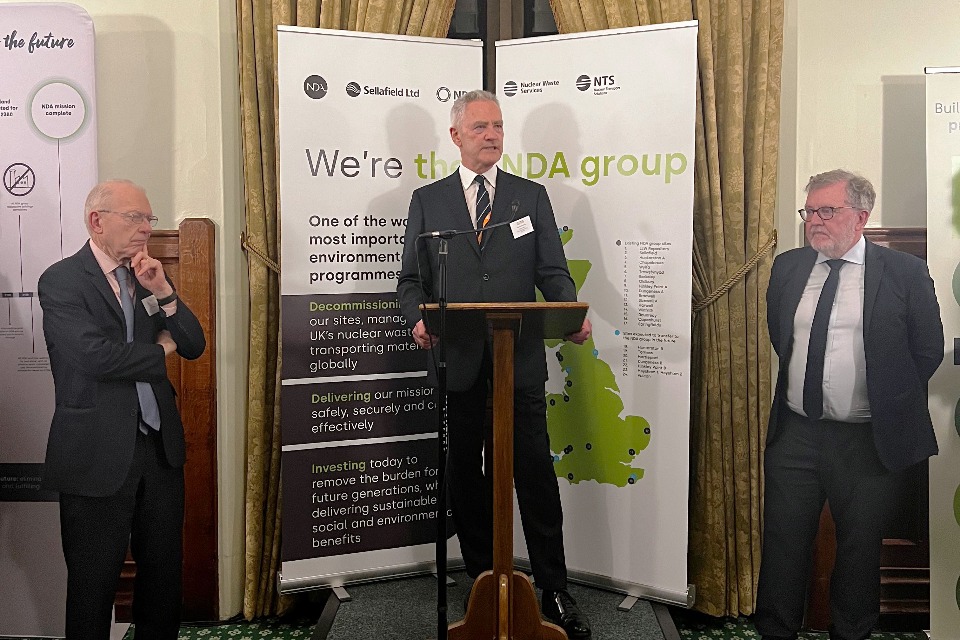At a series of events aimed at MPs and industry stakeholders, the NDA highlighted key successes, such as the first simultaneous retrievals from Sellafield’s high-hazard legacy ponds and silos among other projects
The Nuclear Decommissioning Authority (NDA) showcased groundbreaking advancements in the UK’s nuclear decommissioning efforts at the Nuclear Industry Association’s ‘Nuclear Week in Parliament’ (NWIP), using innovative technology to bring its mission to life. Parliamentarians experienced the future of nuclear decommissioning through virtual reality (VR) headsets, exploring the design of a Geological Disposal Facility (GDF), and getting hands-on with state-of-the-art robots, including drones equipped with laser imaging technology used in the decommissioning of legacy nuclear sites.
This year marks the 20th anniversary of the NDA’s establishment, with the organisation playing a crucial role in the decommissioning of the UK’s oldest nuclear sites. The initiative is regarded as one of the world’s most significant environmental programmes, safeguarding people and the planet.
David Peattie, CEO of the NDA Group, said, “We’re transforming the legacy of the UK’s nuclear power into a sustainable future. As we celebrate our anniversary, we can proudly say the UK is now a significantly safer place, thanks to our collective efforts.”
At a series of events aimed at MPs and industry stakeholders, the NDA highlighted key successes, such as the first simultaneous retrievals from Sellafield’s high-hazard legacy ponds and silos, the safe end of generation and defueling of all Magnox reactors, and the ongoing identification process for a site to house the GDF, the UK’s first community consent-led national infrastructure project. Notably, the NDA has also safely transported over 2,000 casks of nuclear material by sea and conducted over 5 million miles of nuclear rail transports, maintaining a flawless nuclear safety record.
In addition to decommissioning, the NDA group has invested £277 million in socio-economic funding to support sustainable projects in site communities, reprocessed 9,000 tonnes of spent nuclear fuel, and generated £9 billion. The NDA’s efforts have led to the demolition or reuse of 274 buildings and the release of 9% of its land for reuse or redesignation.
The NDA group’s contributions extend beyond decommissioning, with a £100 million investment in research and development to pioneer solutions to complex technical challenges. The group also plays a vital role in sustaining the UK’s nuclear supply chain, spending approximately £2 billion last year across 82% of UK parliamentary constituencies, with 5,000 supply chain companies supporting its mission.
Through its socio-economic strategy, the NDA has leveraged over £200 million in additional funding, attracting nearly four times as much in further investment for impactful projects. The group also sponsors the NWIP Skills and Apprenticeship Fair, where young professionals shared their experiences with MPs and industry representatives.
Rachel Gleaves, a Control Systems Degree Apprentice at Sellafield Ltd., highlighted her role in supporting high-hazard retrievals, stating, “This is a challenge I was really passionate to support. I’ve been able to learn from industry-leading engineers to help safely decommission the nation’s nuclear legacy.”
With more than 1,500 apprentices and graduates currently in early careers schemes and hundreds of PhD students and post-doctoral researchers, the NDA is committed to developing the next generation of nuclear decommissioning talent.
Liz Saville Roberts MP emphasized the importance of nuclear sector jobs in her constituency of Dwyfor Meirionnydd, noting that decommissioning work provides valuable employment and skills opportunities for local youth. She stressed, “Wales should play a leading role in supporting the NDA’s work, delivering benefits to communities, the environment, and the wider economy.”
The NDA’s programme of work is set to last well over a century, making the development of future talent a critical component in ensuring the long-term success of this vital mission.
ALSO READ: The Value of Evidence














